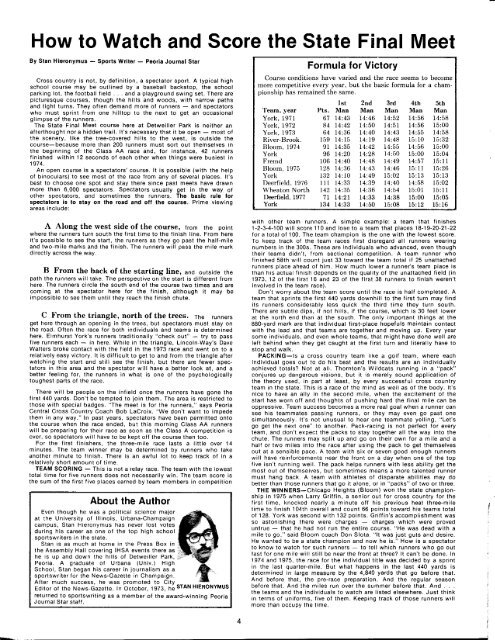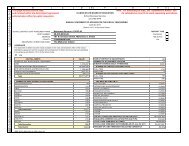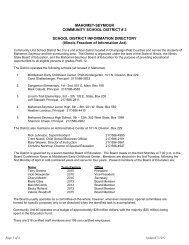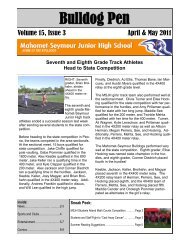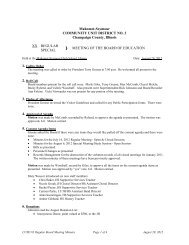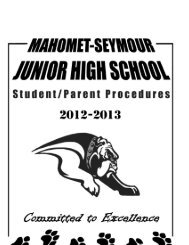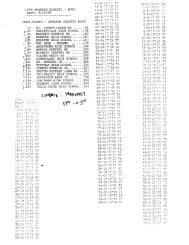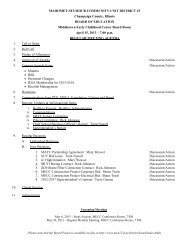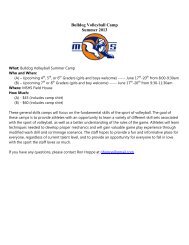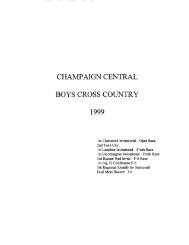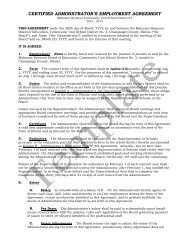1978 State Meet Program - Mahomet-Seymour CUSD #3
1978 State Meet Program - Mahomet-Seymour CUSD #3
1978 State Meet Program - Mahomet-Seymour CUSD #3
Create successful ePaper yourself
Turn your PDF publications into a flip-book with our unique Google optimized e-Paper software.
How to Watch and Score the <strong>State</strong> Final <strong>Meet</strong><br />
By Stan Hieronymus — Sports Writer — Peoria Journal Star<br />
Cross country is not, by definition, a spectator sport. A typical high<br />
school course may be outlined by a baseball backstop, the school<br />
parking lot, the football field . . . and a playground swing set. There are<br />
picturesque courses, though the hills and woods, with narrow paths<br />
and tight turns. They often demand more of runners — and spectators<br />
who must sprint from one hilltop to the next to get an occasional<br />
glimpse of the runners.<br />
The <strong>State</strong> Final <strong>Meet</strong> course here at Detweiller Park is neither an<br />
afterthought nor a hidden trail. It's necessary that it be open — most of<br />
the scenery, like the tree-covered hills to the west, is outside the<br />
course—because more than 200 runners must sort out themselves in<br />
the beginning of the Class AA race and, for instance, 42 runners<br />
finished within 12 seconds of each other when things were busiest in<br />
1974.<br />
An open course is a spectators' course. It is possible (with the help<br />
of binoculars) to see most of the race from any of several places. It's<br />
best to choose one spot and stay there since past meets have drawn<br />
more than 6,000 spectators. Spectators usually get in the way of<br />
other spectators, and sometimes the runners. The basic rule lor<br />
spectators is to stay on the road and off the course. Prime viewing<br />
areas include:<br />
Formula for Victory<br />
Course conditions have varied and the race seems to<br />
more competitive every year, but the basic formula for<br />
pionship has remained the same.<br />
Team, year<br />
York, 1971<br />
York, 1972<br />
York, 1973<br />
River-Brook.<br />
Bloom, 1974<br />
York<br />
Frcmd<br />
Bloom, 1975<br />
York<br />
Deerfield, 1976<br />
Wheaton North<br />
Deerfield, 1977<br />
York<br />
Pts.<br />
67<br />
84<br />
64<br />
159<br />
91<br />
96<br />
106<br />
128<br />
132<br />
111<br />
142<br />
71<br />
134<br />
1st<br />
Man<br />
14:43<br />
14:42<br />
14:36<br />
14:15<br />
14:35<br />
14:20<br />
14:40<br />
14:36<br />
14:10<br />
14:33<br />
14:35<br />
14:21<br />
14:33<br />
2nd<br />
Man<br />
14:46<br />
14:50<br />
14:40<br />
14:19<br />
14:42<br />
14:28<br />
14:48<br />
14:43<br />
14:49<br />
14:39<br />
14:36<br />
14:33<br />
14:50<br />
3rd<br />
Man<br />
14:52<br />
14:51<br />
14:43<br />
14:48<br />
14:55<br />
14:50<br />
14:49<br />
14:46<br />
15:02<br />
14:40<br />
14:54<br />
14:38<br />
15:08<br />
4th<br />
Man<br />
14:56<br />
14:56<br />
14:55<br />
15:10<br />
14:56<br />
15:00<br />
14:57<br />
15:11<br />
15:13<br />
14:58<br />
15:01<br />
15:00<br />
15:12<br />
become<br />
a cham-<br />
5th<br />
Man<br />
14:58<br />
15:00<br />
14:58<br />
15:32<br />
15:00<br />
15:04<br />
15:11<br />
15:26<br />
15:13<br />
15:02<br />
15:11<br />
15:05<br />
15:16<br />
A Along the west side of the course, from the point<br />
where the runners turn south the first time to the finish line. From here<br />
it's possible to see the start, the runners as they go past the half-mile<br />
and two-mile marks and the finish. The runners will pass the mile mark<br />
directly across the way.<br />
B From the back of the starting line, and outside the<br />
path the runners will take. The perspective on the start is different from<br />
here. The runners circle the south end of the course two times and are<br />
coming at the spectator here for the finish, although it may be<br />
impossible to see them until they reach the finish chute.<br />
C From the triangle, north of the trees. The runners<br />
get here through an opening in the trees, but spectators must stay on<br />
the road. Often the race for both individuals and teams is determined<br />
here. Elmhurst York's runners traditionally "check out" — try to pass<br />
five runners each — in here. While in the triangle, Lincoln-Way's Dave<br />
Walters broke contact with the field in the 1973 race and went on to a<br />
relatively easy victory. It is difficult to get to and from the triangle after<br />
watching the start and still see the finish, but there are fewer spectators<br />
in this area and the spectator will have a better look at, and a<br />
better feeling for, the runners in what is one of the psychologically<br />
toughest parts of the race.<br />
There will be people on the infield once the runners have gone the<br />
first 440 yards. Don't be tempted to join them. The area is restricted to<br />
those with special badges. "The meet is for the runners," says Peoria<br />
Central Cross Country Coach Bob LaCroix. "We don't want to impede<br />
them in any way." In past years, spectators have been permitted onto<br />
the course when the race ended, but this morning Class AA runners<br />
will be preparing for their race as soon as the Class A competition is<br />
over, so spectators will have to be kept off the course then too.<br />
For the first finishers, the three-mile race lasts a little over 14<br />
minutes. The team winner may be determined by runners who take<br />
another minute to finish. There is an awful lot to keep track of in a<br />
relatively short amount of time.<br />
TEAM SCORING — This is not a relay race. The team with the lowest<br />
total time for five runners does not necessarily win. The team score is<br />
the sum of the first five places earned by team members in competition<br />
About the Author<br />
Even though he was a political science major<br />
at the University of Illinois, Urbana-Champaign<br />
campus, Stan Hieronymus has never lost votes<br />
during his career as one of the top high school<br />
sportswriters in the state.<br />
Stan is as much at home in the Press Box in<br />
the Assembly Hall covering IHSA events there as<br />
he is up and down the hills of Detweiller Park,<br />
Peoria. A graduate of Urbana (Univ.) High<br />
School, Stan began his career in journalism as a<br />
sportswriter for the News-Gazette in Champaign.<br />
After much success, he was promoted to City<br />
Editor of the News-Gazette. In October, 1973, he STAN HIERONYMUS<br />
returned to sportswriting as a member of the award-winning Peoria<br />
Journal Star staff.<br />
with other team runners. A simple example: a team that finishes<br />
1-2-3-4-100 will score 110 and lose to a team that places 18-19-20-21-22<br />
for a total of 100. The team champion is the one with the lowest score.<br />
To keep track of the team races first disregard all runners wearing<br />
numbers in the 300s. These are individuals who advanced, even though<br />
their teams didn't, from sectional competition. A team runner who<br />
finished 58th will count just 33 toward the team total if 25 unattached<br />
runners place ahead of him. How much lower a runner's team place is<br />
than his actual finish depends on the quality of the unattached field (in<br />
1973, 12 of the first 16 and 23 of the first 38 runners to finish weren't<br />
involved in the team race).<br />
Don't worry about the team score until the race is half completed. A<br />
team that sprints the first 440 yards downhill to the first turn may find<br />
its runners considerably less quick the third time they turn south.<br />
There are subtle dips, if not hills, if the course, which is 30 feet lower<br />
at the north end than at the south. The only important things at the<br />
880-yard mark are that individual first-place hopefuls maintain contact<br />
with the lead and that teams are together and moving up. Every year<br />
some individuals, and even whole teams, that might have done well are<br />
left behind when they get caught at the first turn and literally have to<br />
stop and walk.<br />
PACKING —Is a cross country team like a golf team, where each<br />
individual goes out to do his best and the results are an individually<br />
achieved totals? Not at all. Thornton's Wildcats running in a "pack"<br />
conjures up dangerous visions, but it is merely sound application of<br />
the theory used, in part at least, by every successful cross country<br />
team in the state. This is a race of the mind as well as of the body. It's<br />
nice to have an ally in the second mile, when the excitement of the<br />
start has worn off and thoughts of pushing hard the final mile can be<br />
oppressive. Team success becomes a more real goal when a runner can<br />
see his teammates passing runners, or they may even go past one<br />
simultaneously. It's not unusual to hear one teammate yelling, "Let's<br />
go get the next one" to another. Pack-racing is not perfect for every<br />
team, and don't expect the packs to stay together all the way into the<br />
chute. The runners may split up and go on their own for a mile and a<br />
half or two miles into the race after using the pack to get themselves<br />
out at a sensible pace. A team with six or seven good enough runners<br />
will have reinforcements near the front on a day when one of the top<br />
five isn't running well. The pack helps runners with less ability get the<br />
most out of themselves, but sometimes means a more talented runner<br />
must hang back. A team with athletes of disparate abilities may do<br />
better than those runners that go it alone, or in "packs" of two or three.<br />
THE WINNERS—Chicago Heights (Bloom) won the state championship<br />
in 1975 when Larry Griffin, a senior out for cross country for the<br />
first time, knocked nearly a minute off his previous heat three-mile<br />
time to finish 104th overall and count 66 points toward his teams total<br />
of 128. York was second with 132 points. Griffin's accomplishment was<br />
so astonishing there were charges — charges which were proved<br />
untrue — that he had not run the entire course. "He was dead with a<br />
mile to go," said Bloom coach Don Slota. "It was just guts and desire.<br />
He wanted to be a state champion and now he is." How is a spectator<br />
to know to watch for such runners — to tell which runners who go out<br />
fast for one mile will still be near the front at three? It can't be done. In<br />
1974 and 1975, the race for the individual title was decided by a sprint<br />
in the last quarter-mile. But what happens in the last 440 yards is<br />
determined in large measure by the 4,840 yards that go before that.<br />
And before that, the pre-race preparation. And the regular season<br />
before that. And the miles run over the summer before that. And . . .<br />
the teams and the individuals to watch are listed elsewhere. Just think<br />
in terms of uniforms, five of them. Keeping track of those runners will<br />
more than occupy the time.


